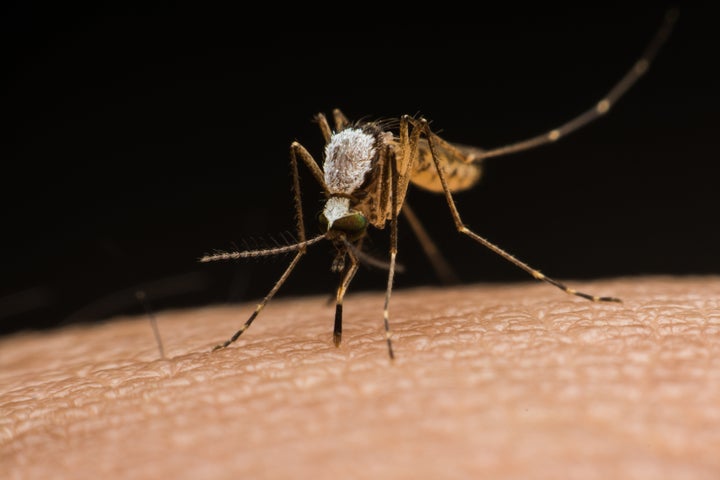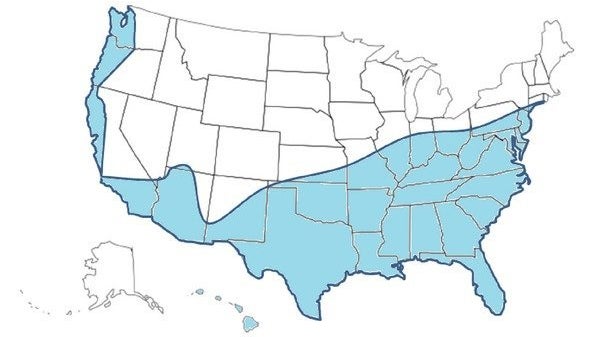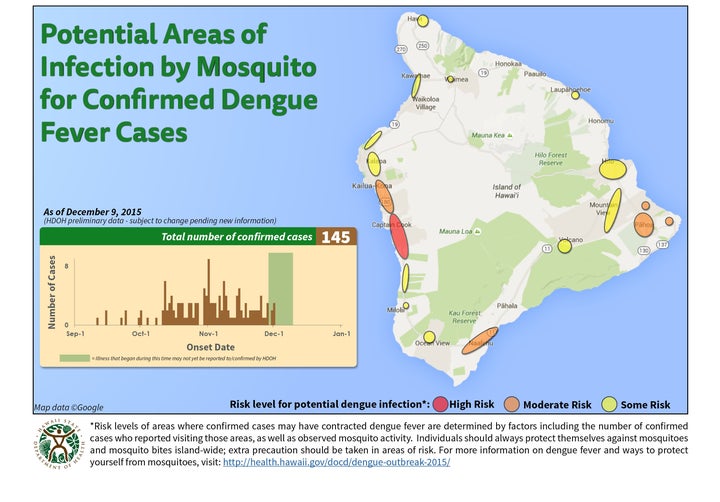HONOLULU -- An outbreak of dengue fever on Hawaii's Big Island has grown into the largest episode of the mosquito-borne illness in the state since the 1940s.
Health officials warn it could last for months -- right through the state's peak tourist season.
"We must be prepared for the long run," Dr. Lyle Petersen, director of the U.S. Centers for Disease Control and Prevention's Division of Vector-Borne Diseases, said during a press conference last week in Hilo.
As of Tuesday, the Hawaii Department of Health confirmed a total of 145 cases of locally acquired dengue -- in 128 Hawaii Island residents and 17 visitors -- since September. HDOH director Dr. Virginia Pressler said during a press conference last week that officials expect to see new cases "identified on a daily basis."

Dengue fever, a viral illness spread by mosquitoes, is not endemic to Hawaii, but the state does have the mosquito species capable of transmitting the disease. Health officials say it is likely that an infected traveler infected the local mosquito population, which in turn led to this cluster of cases.
Symptoms of dengue fever typically begin within a week of being bitten by an infected mosquito and often last between two and seven days. They include fever, rash, joint or muscle pains, headaches, or pain behind the eyes, and, though often debilitating, they can be effectively managed if recognized and treated. Nicknamed "breakbone fever," the virus can develop into a more severe form called dengue hemorrhagic fever that can be fatal if left untreated.
As many as 400 million people around the globe are infected by dengue each year, according to the CDC, but Americans have been largely insulated from the disease. Until the current incident, only three locally acquired dengue fever outbreaks had occurred in the U.S. since 2001, including an outbreak that year on Maui that sickened 122 people. The others occurred in 2005 in Brownsville, Texas (25 cases) and from 2009 to 2011 in Key West, Florida (90 cases).
But according to some experts, the disease could easily strike the mainland again.

Infectious diseases specialist Dr. Amesh Adalja of the University of Pittsburgh Medical Center's Center for Health Security told The Huffington Post on Tuesday that many states, including Texas, Florida and parts of California, are home to the mosquito species capable of transmitting the disease.
"There is definitely a potential for larger dengue outbreaks," he told HuffPost. "The mosquito vector is widespread in certain parts of the United States and permanent reestablishment is a real risk given travel patterns."
And with Hawaii now in its third outbreak in 14 years, Adalja said it's safe to say there are likely to be pools of mosquitoes that harbor the virus.
"This outbreak is evidence of that phenomena," he said.
Hawaii's tropical environment, which allows dengue-carrying mosquitoes to thrive, makes it especially prone to outbreaks of the virus. At the turn of the century, according to a 2005 report, Hawaii saw 30,000 cases. From 1943 to 1944, another epidemic on Oahu resulted in 1,498 confirmed infections. That outbreak is thought to have been introduced by airline pilots who arrived from Fiji, which was suffering an epidemic at the time.
Dr. Sarah Park, an epidemiologist with the state's health department, told HuffPost that Hawaii has been fortunate to have only experienced three outbreaks in modern times. The current outbreak marks the first locally acquired cluster in Hawaii since four people contracted dengue on Oahu in 2011.
While only 17 tourists have been infected so far, one of them was vlogging star Allie Wesenberg who, with her boyfriend Charles Trippy, vacationed on the Big Island in October. Trippy posted numerous videos and updates about Wesenberg's illness, including the clip above, bringing a spotlight to the disease and the risk to tourists.
"I’ll be real honest with you, I seriously thought I was going to die," Wesenberg said. "I’m not kidding you when I say that because they couldn’t figure out what was wrong with me."
West Hawaii Today reports that visitors to the Big Island have voiced concerns that hotels there are not informing guests about the situation. The Hawaii Tourism Authority, however, said in a statement that it will continue working with the tourism industry to "ensure that visitors to Hawaii know that it is safe to travel to the Hawaiian Islands and what precautions should be taken if they are planning to visit areas where cases have been found."
To help stop the spread of the disease, health officials are encouraging residents and travelers on the Big Island to use mosquito repellents and wear long sleeves and pants to limit exposure, as well as eliminate standing water around properties.
So far, the outbreak has not reached neighboring islands.

Last month, as the number of confirmed cases on the Big Island continued to climb, the HDOH called in the Hawaii National Guard to assist the agency in a "support role" that involved flying mosquito sprayers from Oahu to the Big Island.
The military, which has a large presence in Hawaii, is also stepping up their own efforts to fight the outbreak. Last week, Hawaii Biotech Inc. was awarded a contract by the U.S. Army to develop an “effective dengue vaccine to protect military personnel against this potentially mission-aborting disease.” And West Hawaii Today reports the U.S. Navy is also on standby to help battle the outbreak.
Experts from the CDC are expected to remain on the island for at least the next two weeks, according to local news station KHON 2, conducting advanced molecular tests, providing test kits and advice, and working with epidemiological teams.
Park said that while it's impossible to predict what to expect moving forward, she's optimistic the outbreak can be stopped if everyone works together.
"I'm certainly hopeful that the trickle (of cases) will slow or stop sooner than later," she told HuffPost.
Also on HuffPost: